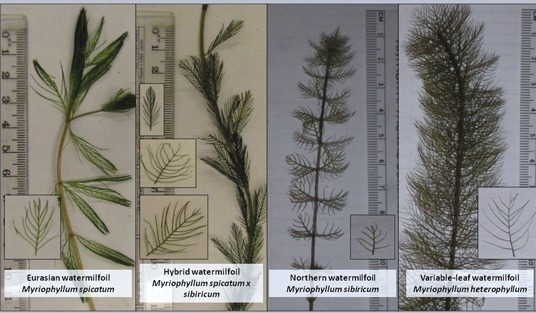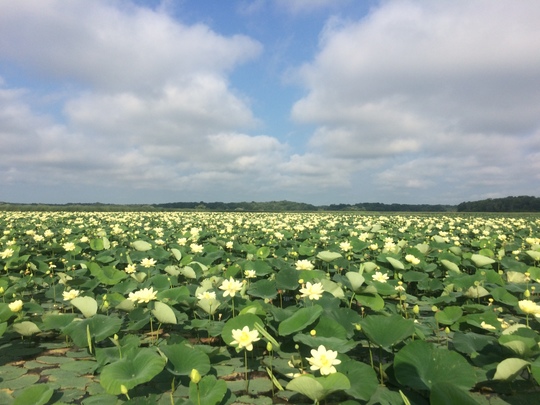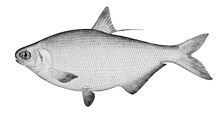 Photo from Michigan Tech Research Institute
Eurasian watermilfoil (EWM) is a common aquatic invasive species found in many of our lakes. However, watermilfoil is a diverse group of plants and there can be many different genetic differences within the watermilfoils. Eurasian Watermilfoil can cross-pollinate and hybridize with native northern watermilfoil known has Hybrid Watermilfoil (HWM). These hybrid species can then cross-pollinate with the numerous milfoil species. Even waterbodies that are close to one another may have unique genetic strains of watermilfoil. HWM is of concern because it may grow more aggressively and may be more tolerant to commonly used herbicides. HWM cannot be identified in the field as it can contain a mix of characteristics from both the Eurasian and Native watermilfoil. The only way to confirm HWM is through genetic testing.
A recent study titled Evaluation of large-scale low-concentration 2,4-D treatments for Eurasian and hybrid watermilfoil control across multiple Wisconsin lakes was published in Lake and Reservoir Management by Nault et al. This study looked at 23 lakes in Wisconsin pre and post a 2,4-D treatment. The researchers were looking at how 2,4-D dissipates and moves throughout the water as well as how well it worked to control EWM and HWM. The study showed that herbicides move quickly off of treatment areas, which is important for lake managers to understand and consider as they are planning for lake treatments. According to the study, if the percentage of treated areas to overall lake surface area is >5% and the targeted areas are treated at relatively high 2,4-D concentrations (2-4 ppm), then there is increased chance for dissipation of concentrations that could have a lake-wide impact.
In the 23 lakes studied, there was better control on the lakes that contained pure EWM. Previous research has also shown that HWM may be more resistant to 2,4-D than EWM. The study also showed that several native plant species showed a decline during the first year post-treatment. The species most significantly impacted were: Northern Watermilfoil, Slender Naiad, Water Marigold, several pondweeds (Illinois, Flat-stem, Sago etc.) and Water Stargrass.
This study provides good insight for lake managers. Understanding what genetic type of watermilfoil is present in the lake, how 2,4-D can dissipate off a treatment site, and potential impacts to native plant species are important factors to take into consideration when planning for a lake treatment.
"Muskie appears to have gained between 1 and 2 pounds per fish since gizzard shad showed up. Males are about 1 pound heavier and females are about 2 pounds heavier for older mature fish. A 45" female musky in 2006 weighed about 27.7 pounds and a 45" female in 2012 weighed about 29.9 pounds" - Frank Jakubicek, IDNR Fisheries Biologist
American Gizzard Shad (Dorosoma cepedianum) are native to central and eastern
United States mainly in warm low gradient rivers
and streams as well as reservoirs, lakes and
ponds. Shad are filter feeders preferring warm
nutrient rich waters. Their range is temperature
limited. Die offs usually occur when the water
temperature drops below 37°F. Shad can extend
their range during a string of warm years; the
Illinois DNR collected its first sample of gizzard
shad in the Fox Chain O‘ Lakes in 2007. It's likely these
shad migrated up the Fox River over fish ladders
and dams to make it to the Chain. Lakes
that receive flood waters from the Des Plaines
River can also have them.
While most shad live for 3-5 years, some have
been documented to live past 10 years. They
reach maturity in 2-3 years and females can
produce between 40,000 to 450,000 eggs. Spawning takes
place during the middle of spring to early summer
and usually occurs in the evening. The preferred
spawning temperature is between 60°F and 70°F.
Male and female shad congregate along the
shallow sandy or gravel areas where eggs are
released and fertilized. The success of the shad fry
correlates with the abundance of zooplankton
along with stable water level and warmer
temperatures. Drastic changes in water level
and temperature can decrease the survival rate of
the fry. Once they reach the juvenile stage, they
grow rapidly by feeding mostly on phytoplankton
and zooplankton. At this stage they develop a 'gizzard' and begin filter feeding for food.
Sediment and sand are also ingested by the gizzard shad that helps it to digest food. It's
muscular gizzard; this is where the fish gets its name.
Fishermen on the Fox Chain O‘ Lakes have
seen large schools of shad swimming in
the shallow weedy bays. While they are rarely
caught with the traditional hook and line, most
anglers inadvertently snag shad with their hook
or lure while targeting game fish. Gizzard shad
provide an abundant food source for bass and
walleye, but they may compete with bluegill,
crappies and other young of the year game-fish
for food. Shad have rapid growth rates, often
growing 5.5 inches in length during their
first year. This provides a smaller window of
opportunity for bass and walleyes which are
gape limited, meaning they are limited by their mouth size, and can only feed effectively on
shad up to 6". The lakes and rivers in southern
states have an over abundance of adult shad
measuring 8" or larger due to lack of predators.
Fortunately, the Chain has a healthy population
of muskies, which are capable of feeding on
adult shad. Muskies have benefited from this
new food source which is not only abundant but
it‘s easier for them to catch than bluegills or perch. The less energy a fish spends chasing its
prey the more energy it saves for growing.
Gizzard shad can alter the size and density
structure of a fishery. They may stunt the
bluegill population through common food
competition or by reducing the predation
pressure. This allows for higher recruitment
which leads to stunted population. Bass may
grow larger due to having more food available
for them to eat, but their fry may have to
compete for food. At this point it is hard to
predict what the overall outcome of the gizzard
shad will be on the fishery. At least for now, it
gives fishermen hope that the shad will help
produce record size game fish.
Creating Riparian Landscapes , July 10th, 2018 @ 10 AM
Barrington Area Library, 505 N. Northwest Hwy, Barrington, IL
This presentation will be led by Bob Kirschner, Curator of Aquatic Plant & Urban Lake Studies and Director of Restoration Ecology, Chicago Botanic Garden.
Let’s face it: native plantings along the edges of lakes and streams are sometimes viewed as being too messy and “weedy”—as compared to a more typical home landscape where foliage color, abundance of flowers, and seasonal interest are all considered important. Thoughtful integration of such “gardening” aesthetics into riparian landscapes, together with defining features such as pathways and edging, combine to create visual “cues to care” that reinforce the landscape’s intention while still providing considerable ecological benefit to the waterway. We’ll take a look at how thoughtful design and careful selection of native plants can turn shoreline landscapes into ones that enhance water quality and habitat—AND are the envy of your neighbors!
Everything you Wanted to Know about Carp and Carp Control
July 17th, 2018 @ 7:00 PM, Barrington Area Library
Frank Jakubicek, IDNR
District Fisheries Biologist for Lake and Cook County, will speak about carp,
their impact on lake and river habitats, and strategies for their management
and control.
The common carp, first
imported into the U.S. in the 1850's, are pervasive and now are considered
"native." Frank has dealt with carp issues for years, and will
share his perspectives on carp control from both a biological perspective and a
management perspective, noting which measures work, under what
conditions, and for how long. Come, gain insights into how to manage
these fish that tear up our relatively shallow, soft-bottomed lakes, increasing
turbidity, uprooting beneficial aquatic plant life, creating tough living
conditions for game fish, and complicating lake and stream management for all
of us.
Aquatic Plant Identification Workshop: August 1, 2018, 1:00 - 4:00 PM
500 W. Winchester Rd. Libertyville, IL 60048
Join the Lake County Health Department and Illinois Lakes Management Association (ILMA) for an aquatic plant identification workshop. Participants will learn to identify native and invasive plants in their lake with hands on identification. The workshop will include real-plant ID on rooted floating vegetation, non-rooted floating vegetation, and submerged vegetation.
An RSVP is required. RSVP to Alana Bartolai at abartolai2@lakecountyil.gov or (847) 377-8009.
 |
|
The Lake County Health Department-Ecological Services (LCHD-ES) and the Chicago Metropolitan Agency for Planning (CMAP) has hosted a couple Lake Management Planning Workshops.
There are many components that go into creating a Lake Management Plan for your lake. To help and empower anyone responsible for making lake management decisions, such as homeowner associations, municipalities, and park and forest preserve districts, LCHD and CMAP has created a Lake Management Planning Guide full of useful information, worksheets and templates.
Download the Lake Management Planning Guide, templates, and data samples
|

Clues
- Large tuber can be used as a food source
- Floating plant with one yellow flower
- Large leaves, can be up to 2.75 feet in diameter
- Can be found in quiet waters
Think you know the answer? Email your best guess to ABartolai2@lakecountyil.gov.
Our Team
Mike Adam, Senior Biologist
Gerard Urbanozo, Water Quality Specialist
Alana Bartolai, Water Quality Specialist
|






